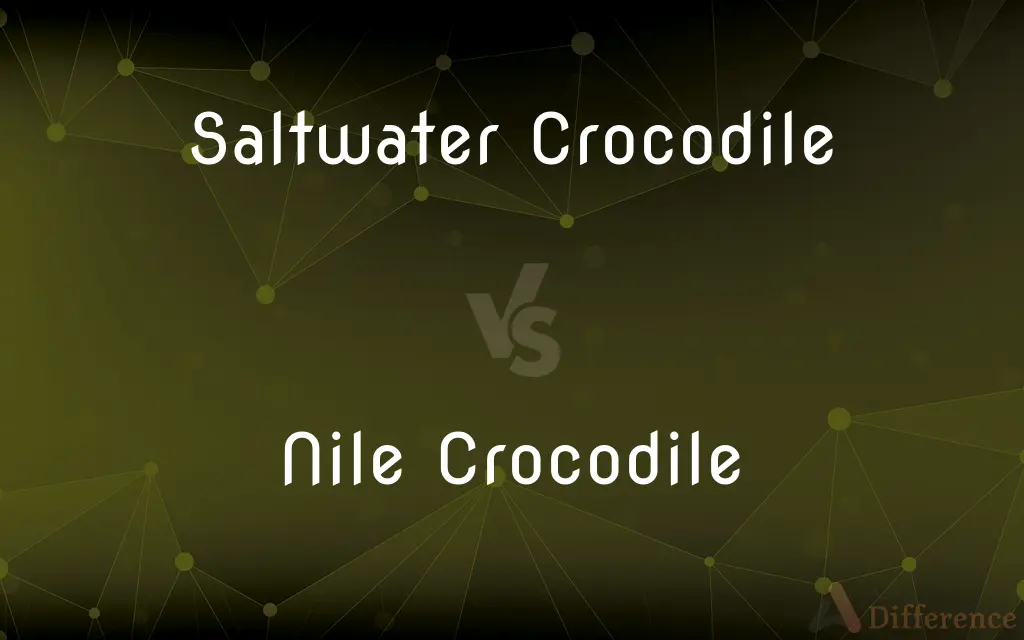Saltwater Crocodile vs. Nile Crocodile — What's the Difference?
Edited by Tayyaba Rehman — By Fiza Rafique — Published on December 27, 2023
Saltwater Crocodile, native to Southeast Asia and Australia, is the world's largest reptile; Nile Crocodile, from Africa, is smaller but more aggressive.

Difference Between Saltwater Crocodile and Nile Crocodile
Table of Contents
ADVERTISEMENT
Key Differences
Both the Saltwater Crocodile and Nile Crocodile are apex predators, but they inhabit different regions. The Saltwater Crocodile, often called "salty," finds its home primarily in Southeast Asia and northern Australia. In contrast, the Nile Crocodile is exclusively African, residing mainly in the freshwater regions of sub-Saharan Africa.
In terms of size, the Saltwater Crocodile holds the title of the world's largest living reptile. It can grow up to 7 meters or more. The Nile Crocodile, while also impressively large, generally measures between 4 to 5 meters, although larger specimens have been documented.
Behaviorally, both the Saltwater Crocodile and Nile Crocodile are formidable predators, but their aggression levels differ. The Nile Crocodile is often considered more aggressive toward humans than its saltwater counterpart.
While the Saltwater Crocodile can thrive in both saltwater and freshwater environments, it's most commonly found in mangroves and estuaries. The Nile Crocodile predominantly sticks to freshwater habitats like rivers, lakes, and marshlands.
Conservation statuses vary for the Saltwater Crocodile and Nile Crocodile. While efforts have stabilized the Saltwater Crocodile population, making it of "Least Concern," the Nile Crocodile remains under more threat due to habitat loss and human conflict, although it's not critically endangered.
ADVERTISEMENT
Comparison Chart
Native Region
Southeast Asia and northern Australia.
Sub-Saharan Africa.
Size
World's largest reptile, up to 7 meters or more.
Typically 4 to 5 meters, though larger ones exist.
Aggressiveness
Less aggressive than Nile Crocodile.
More aggressive, especially toward humans.
Habitat
Found in both saltwater and freshwater, favors mangroves and estuaries.
Predominantly freshwater habitats like rivers, lakes, and marshlands.
Conservation Status
Generally of "Least Concern" due to conservation efforts.
Not critically endangered but faces threats from habitat loss.
Compare with Definitions
Saltwater Crocodile
The world's largest living reptile.
The size of the Saltwater Crocodile is truly awe-inspiring.
Nile Crocodile
Resides mainly in sub-Saharan Africa.
The Nile Crocodile's range is extensive in the African continent.
Saltwater Crocodile
Can thrive in both saltwater and freshwater.
Unlike many crocodilians, the Saltwater Crocodile can handle ocean waters.
Nile Crocodile
A dominant predator in African freshwater habitats.
The Nile Crocodile is a fearsome presence in African rivers.
Saltwater Crocodile
Native to Southeast Asia and Australia.
You can find the Saltwater Crocodile in mangroves in northern Australia.
Nile Crocodile
Can grow impressively large, though usually smaller than Saltwater Crocodile.
While huge, the Nile Crocodile doesn't typically reach 'salty' sizes.
Saltwater Crocodile
Population stabilized through conservation.
Conservation efforts have been effective for the Saltwater Crocodile.
Nile Crocodile
Notably aggressive, especially towards humans.
Villagers near rivers often fear the Nile Crocodile due to its aggressive nature.
Saltwater Crocodile
Known as "salty" colloquially.
Many locals refer to the Saltwater Crocodile simply as 'salty.'
Nile Crocodile
Faces threats mainly from habitat loss.
For the Nile Crocodile, shrinking habitats present a significant challenge.
Common Curiosities
Where are Saltwater Crocodiles found?
Saltwater Crocodiles are native to Southeast Asia and northern Australia.
Which crocodile is larger in size?
The Saltwater Crocodile is the world's largest reptile.
Are Nile Crocodiles more aggressive than Saltwater Crocodiles?
Yes, Nile Crocodiles are generally more aggressive, especially towards humans.
Do Saltwater Crocodiles live in the ocean?
They can live in both saltwater and freshwater, but they're commonly found in mangroves and estuaries.
What do Saltwater Crocodiles typically eat?
They have a varied diet, including fish, birds, and mammals like kangaroos and wild boar.
How do Nile Crocodiles hunt their prey?
They often use an ambush strategy, waiting underwater near the edge and then quickly lunging at their prey.
How many eggs can a Nile Crocodile lay at a time?
A female can lay between 25 to 80 eggs, depending on her size.
What's the primary habitat of the Nile Crocodile?
The Nile Crocodile mainly inhabits freshwater regions like rivers, lakes, and marshlands in sub-Saharan Africa.
Why are Nile Crocodiles considered a threat to humans?
Due to their aggressive nature and frequent encounters with humans near freshwater sources in Africa.
How long can Saltwater Crocodiles live?
They can live for 70 years or more in the wild.
Is it safe to swim in areas inhabited by Saltwater Crocodiles?
No, it's hazardous due to their predatory nature.
Are Saltwater Crocodiles endangered?
No, their population has stabilized due to conservation efforts and they're listed as "Least Concern."
How fast can a Saltwater Crocodile swim?
They can reach speeds of up to 24 km/h (15 mph) in short bursts.
Do Nile Crocodiles have any predators?
While young ones can be preyed upon by large birds or other crocodiles, adult Nile Crocodiles have few natural predators.
How do Nile Crocodiles communicate?
They use a combination of sounds, body movements, and postures.
Share Your Discovery

Previous Comparison
Local Time vs. Standard Time
Next Comparison
DMAIC vs. DMADVAuthor Spotlight
Written by
Fiza RafiqueFiza Rafique is a skilled content writer at AskDifference.com, where she meticulously refines and enhances written pieces. Drawing from her vast editorial expertise, Fiza ensures clarity, accuracy, and precision in every article. Passionate about language, she continually seeks to elevate the quality of content for readers worldwide.
Edited by
Tayyaba RehmanTayyaba Rehman is a distinguished writer, currently serving as a primary contributor to askdifference.com. As a researcher in semantics and etymology, Tayyaba's passion for the complexity of languages and their distinctions has found a perfect home on the platform. Tayyaba delves into the intricacies of language, distinguishing between commonly confused words and phrases, thereby providing clarity for readers worldwide.
















































